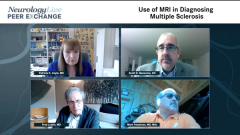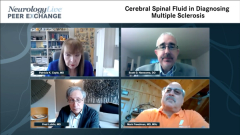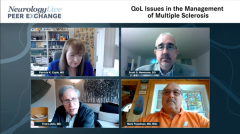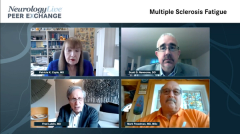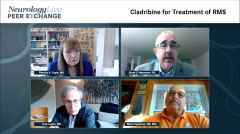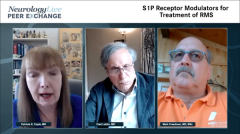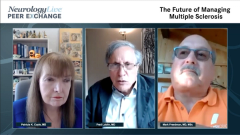
2017 Changes to the McDonald Criteria: Diagnosing Multiple Sclerosis
Episodes in this series

Fred Lublin, MD, leads a discussion on the 2017 changes to the McDonald criteria for the diagnosis of multiple sclerosis.
Fred Lublin, MD: Hello, and welcome to this Neurology Live® Peer Exchange® titled “Updates in the Management of Multiple Sclerosis.” I’m Dr Fred Lublin from the Corinne Goldsmith Dickinson Center for Multiple Sclerosis at Mount Sinai Hospital in New York, New York. Joining me in this discussion are my colleagues Dr Patricia K. Coyle from Stony Brook University Neurosciences Institute in Stony Brook, New York; Dr Mark Freedman from the University of Ottawa Department of Medicine and the Ottawa Hospital Research Institute in Ottawa, Ontario, Canada; and Dr Scott D. Newsome from the Johns Hopkins Multiple Sclerosis and Transverse Myelitis Centers in Baltimore, Maryland.
Today we’re going to discuss a number of topics pertaining to the diagnosis of multiple sclerosis [MS], including a focus on fatigue and its impact on quality of life. Let’s get started with our first topic, diagnosis of multiple sclerosis.
People have been diagnosing multiple sclerosis all the way back to 1868, when Jean-Martin Charcot described the clinical aspects and some of the pathology of the disease. That includes dissemination in time and space, meaning more than 1 episode and involving more than 1 area of the central nervous system.
A number of diagnostic criteria have been published over the years, but the first to incorporate MRI scanning in a major way were the McDonald criteria. Those were published in 2001 by an international committee and individuals who had an interest in multiple sclerosis. Those criteria brought MRI into the modern era of diagnosis of MS. We were using it, but they helped standardize it by applying some data and using the MRI at times as a surrogate for clinical events.
The McDonald criteria were revised in 2005 and revised again in a major way in 2010. The latest revision was in 2017, and this was published in The Lancet Neurology.
Let’s discuss some of the key changes the 2017 McDonald criteria set. Patricia, why don’t you start?
Patricia K. Coyle, MD: First of all, they added cortical lesions to juxtacortical lesions as a dissemination-in-space site. Second, you can count symptomatic lesions as well as asymptomatic lesions. Third, they gave a second way to make a definite diagnosis of MS with a single attack of a clinically isolated syndrome. You must have ruled out other possibilities, but if you meet dissemination in space by MRI criteria and you have CSF [cerebrospinal fluid]–specific oligoclonal bands, you can qualify for a definite diagnosis with 1 attack. That was brand-new. The criteria elevated CSF-specific oligoclonal bands. That is the key test and is even above the IgG index.
Then they clarified clinical syndrome to be a very crisp clinically isolated syndrome. They didn’t mandate it, but they strongly encouraged imaging the spinal cord and looking at cerebrospinal fluid. They clarified some of the MRI issues. The lesions should be at least 3 mm or larger. Periventricular lesions have to abut the ventricles, while juxtacortical lesions have to abut the cortex. They clarified a lot of things.
Fred Lublin, MD: Scott, tell us a bit more about MRI. In 2017, they brought CSF to the front and let that be a surrogate for dissemination in time. The idea was that if someone had a clinical event and met criteria for dissemination in space instead of dissemination in time on the MRI, they could have oligoclonal bands. The major change throughout the core McDonald criteria has been use of the MRI. Tell us a bit about that.
Scott D. Newsome, DO: Sure. I’d like to say that MRI, to this point in time, is the most sensitive tool that we have in the diagnosis of MS and following people over time. Once we start treatment, it allows us to see if someone has a subtherapeutic response to treatment or not.
I remember trying to study and put in the back of my memory banks how many T2 lesions you need—9 T2 lesions, etc—to help make a diagnosis of MS. Now it’s been refined in way that makes things a lot easier for the clinician to make a diagnosis as long as it’s in the context of the appropriate clinical syndrome and ruling out other imitators.
When we think about the revised criteria, what I feel has been helpful in clinical practice is that symptomatic lesions can now count as 1 of the dissemination-in-space criteria with imaging and the McDonald criteria. Also, if someone has an enhancing lesion, even if it’s their first MRI, with their first attack, you can qualify that as dissemination in time and not necessarily need additional work-up besides ruling out the imitators.
I don’t want to belabor the point. I would say that the imaging—the MRI specifically—is the most helpful tool. Pat, you had mentioned the characteristics of some of the lesions we look for. Looking for those characteristic regions within the brain that get involved can help with your differential diagnosis as it relates to MS.
Newsletter
Keep your finger on the pulse of neurology—subscribe to NeurologyLive for expert interviews, new data, and breakthrough treatment updates.

